Disclaimer: This review entails racist content and imagery with the intended use of historical and informational context. I ask that you speak up in the case I say something that is offensive, harmful, or perpetuating so that I may take the appropriate accountability. Thank you.
Release Date: July 19th, 1941
Series: Merrie Melodies
Director: Chuck Jones
Story: Rich Hogan
Animation: Phil Monroe
Musical Direction: Carl Stalling
Starring: Mel Blanc (Scream, Effects)
(You may view the cartoon yourself here.)
“… Leon told me to do another one. I said, ‘Well, you hated the first one, I don’t see why you [want to] do it now.’ He said, ‘I changed my mind.’ Of course, what he meant was that he had received word [The Little Lion Hunter] had done well in theaters.”
There you have it: Chuck Jones’ very own account as to why this cartoon—and the Inki series as a whole—exists.
Perhaps Inki is a character best viewed as a time capsule. Not just because of the egregiousness of his looks (which does admittedly play a part), but, given his almost surprisingly robust lifespan, he serves as an ever shifting indicator of Chuck Jones’ artistic priorities.
The Little Lion Hunter was made at a great time for Jones. He was amidst the peak of his “Disney era”, as historians so colloquially asses it, but within the peak of the Disney era actually looking good. Lion Hunter boasts an amazing sense of production value even today. Its animation is sculpted, solid, tactile and lush to an almost disarming degree, cel shading lingering on nearly every single frame. The character acting and pantomime in that cartoon largely served as a reflection of such sentiments, too.
Inki and the Lion, on the other hand, is much more divorced of those Disneyisms. A lot has changed within the span of nearly two years. Jones’ cartoons have gotten quicker, smarter, more abrasive. His directorial identity was solidifying. No longer were his shorts merely regarded as cartoons made in the shadow of Disney—now, there is a clear disconnect between priorities, tone, and humor.Lush, rich, meticulous animation isn’t as much of a priority as it once was. Especially compared to Lion Hunter, Jones’ mission now lies in finding ways to make the animation funny and captivating. Not realistic and stunning. Humor and exaggeration has the capability to stun just as much as grandiose art direction. Indeed, the Warner-fication of Jones has been a slow yet steady simmer of progress.
Those results are immediately reflected in this picture. Instead of showing off the believability of a little kid toddling along, how his head and body can be viewed at all angles, how he occasionally spares a funny facial expression just like us, priorities skew more towards gag density. Inki may be less rich in his drawing style, but is given a newfound zest and energy to better fit the mission and tone of this cartoon. Gag density. Caricature. Exaggeration. Any and all foundations established by Lion Hunter are acknowledged and utilized as a springboard for the next step of directorial evolution.
Thus, the audience is greeted to this suddenly “modern” Inki of 1941, what with his newfound exaggerations and deftness and complacency in furthering a gag or two. Plot of the short is exactly as the title alludes to: Inki has a run-in with a lion, and laughs are surely a-plenty as he finds various ways to escape. Various ways that are interrupted through the persistence of an old, enigmatic friend.
Surely there is a law somewhere that dictates every outing with Inki must feature a foreboding accompaniment of “Fingal’s Cave”. This is by no means a bad thing—the repeated familiarization bestows an identity to these shorts. Even if viewers don’t exactly recall the details or story of the various Inki shorts, they may at least recount the music.
Thus, much like The Little Lion Hunter, the cartoon comes to an open with a scenic pan of the jungle, “Fingal’s Cave” playing as a smooth growl beneath. Even the speed of the horizontal pan indicates a growing embrace and awareness of Jones’ sense of timing; it’s much quicker than the elaborate, vertical and horizontal pans flaunted in Lion Hunter. More business to attend to more quickly.
Especially given that the pan in itself is a subversion. Just as the audience gets settled, expecting Inki to come hobbling along out of the brush, their senses are assaulted through the sudden explosion of a monkey running frantically on the screen. From the opposite direction, no less—the camera pan right was all just a deliberate fake-out.
Cleverly, the trip back to screen left is much longer than the trek to screen right. A logical conclusion, of course, but intriguing when realizing that the plant overlay seen in the very first frames of the short, insinuating a “start” to the jungle are missing. Such opens up more room for the action on the screen and sheds insight onto Jones’ directorial intentions: the surprise aspect was, indeed, very purposeful.
With the monkey seeking refuge in the tree, Inki tinkers in to scope things out. Already, his movements are much more spry, quick, less toddling than Lion Hunter’s affairs. Lion Hunter sought to endear. This short seeks to apply. There’s no time for cutesy hobbling, skipping, or other studies of the Disney philosophy when fresh meat lingers nearby.
Jones would reprise this informal “mirror bit” later in the cartoon. Here, it’s a bit more reminiscent of the aforementioned cutesiness, but not to a degree of utter coyness or accidental disingenuousness. Mischief remains the priority.
Particularly when Inki finds himself the grand recipient of a coconut to the head. Jones straddles the sweet spot of retaining the coherency of the gesture, while also delivering it as a surprise. By the suddenness in which the coconut is lobbed on screen and knocks Inki over, the viewers are just as blindsighted as he is—thus, a little more sympathy and understanding shared his way. Making such a point to show the monkey hiding in the tree (and Inki’s motives), the resolution nevertheless comes as a logical conclusion. Mess with the bull, get the horns.
Granted, Inki’s comeuppance is just as brutal. Perhaps even more: the suddenness in which he tosses the spear at the monkey is much more violent and surprising than the comparative domesticity of the coconut throwing. Mel Blanc’s agonized screaming really drives the point home. Two acts of violence contained to the first minute of the cartoon alone, Jones seems eager to rectify any lugubriousness in the short’s earlier installment.
Three acts of violence. Reverberations of the spear as it writhes in the ground are conveyed through opaque cel paint—not the usual unobtrusiveness of a dry brush afterimage. Distortions and strength of the elastic tension call more attention through the boldness of the opaque multiples, further justifying Inki’s movements as he writhes and jumbles around on top of the spear. Jones’ improvements and attempts to be more daring aren’t just through large, standard directing maneuvers. It can even manifest itself through something as menial as coloring a multiple opaque.
Inki is nevertheless determined to get his revenge. There’s no giving up and retreating, much to the swelling hearts of charmed audiences everywhere.
At least, not regarding the monkey. Cacophonous crunching, snapping, and breaking sounds indicate more menacing predators lurk nearby: such is Inki’s cue to flee. The copious dry brushing that ensues to depict his frantic exit would never have been found in Lion Hunter, which made a point to demonstrate Inki running, galloping, and toddling as much as it could. Such shortcuts weren’t Jones’ directorial priority at the time, just as that richness and illusion of life isn’t his priority now.
Palm leaves bristle and shake and sway to give a geography to the cacophony. While slight, a lag does persist—the leaves seem to convulse only when the camera finally settles to a stop, rather than moving and jittering beforehand. A very minor dissonance thereby occurs, the movements of the leaves seeming mechanical and forced rather than a natural reaction to outside forces. Jones communicates the intent clearly, which is arguably the most important objective: something unfriendly clearly lurks behind the curtain of shrubbery. A minor miscalculation just prompts the audience to take an extra moment in discerning what’s happening.
Who else should enter but the ever enigmatic mynah bird. His role is the exact same as his role in Lion Hunter: enigmatically appear on screen, hopping to Stalling’s plodding accompaniment of “Fingal’s Cave” with surprising apathy, and occasionally demonstrating incomprehensible feats of strength that never are—nor should be—explained. So much so that even Jones didn’t understand him (nor the cartoons), citing them as “fourth dimensional pictures.” More about the inception of the Inki series can be read in the analysis of The Little Lion Hunter for anyone who missed it or may desire a refresher.
Cutting from the mynah to a sudden shot of Inki observing the mynah is jarring, sudden, but technically out of necessity. The camera seems to jump between two separate locations, as though there was a sudden skip in time. Such is an unintended consequence. Rather, the mynah moves slowly. Very slowly. Taking the extra time to have him gallop past the tree, spurring the cue for the camera to close in on him would be much more of a nuisance than any momentary confusion at a lack of hook-up poses. It’s a sacrifice, but one Jones was probably more intelligent to risk than not.
It moreover proves beneficial in establishing the forthcoming parallel: a close-up of the mynah melts into a camera pan left, revealing Inki to be pursuing him with the same hopping gait. A deliberate reprise of the same routine in The Little Lion Hunter, studying the differences in Jones’ art direction once again proves fascinating. Lion Hunter is dominated by intricate highlights and shadows, rendering it much more elaborate than the alternative here—the difference is that, again, grandiosity isn’t Jones’ single priority. A confidence is moreover communicated through the decision to excise the shadows. Outside of being cheaper and less strenuous on the artists and inkers, it seems to indicate that Jones doesn’t feel he has to use shadows as a visual crutch. The construction and solidity is still all there; no need for extra decorative fluff to shove it into the audience’s faces.
The spear that Inki lobs at the bird unintentionally transforming into a platform for him to walk on is, likewise, a reprisal from the same cartoon. Length of the spear is much longer, clarifying the gag and making it read to a somewhat more bombastic effect. Stakes are likewise higher as the spear lands narrowly above the jaws of a shiny bear trap; painted red, the jaws convey alarm and danger, as well as clearly stand out against more natural hues of the lush, green flora.
Exaggerated length of the spear’s handle offers room for a continuation of the gag, too. Inki’s convulsions as he reverberates aimlessly on the spear handle are maybe regarded with a bit too much pep, but that is entirely the point—it’s alarming, abrasive, and abstract. Loud, cacophonous sound effects support this mission of polite absurdity.
Cornering the mynah into the hollow of the tree does prove to reap its benefits, as there’s no way for it to outrun (er, gallop) Inki now. As he reaches into the hole, Jones and his animators tout the dimensionality of Inki through some incredibly impressive head tilts and otherwise intricate angles. Construction is solid, dimensional, tactile; another indication that Jones has outgrown the reliance on cel shading to embrace the dimensionality. Its depth and solidity reads all for itself.
Given the nearly absurd amount of solidity, it inadvertently encourages a disconnect in the animation. Inki grabbing the mynah from within the trunk and violently jostling it reads as much more melty, plastic, and loose—obviously, that comes with the territory, as the violent outburst is meant to serve as an incongruity against the docile, smooth construction. Likewise, maintaining such rigid structure in a frantic maneuver that seeks to be violent and fast would cause more trouble than not. There’s also the consideration that the mynah is meant to be ambiguous and nondescript, appearing as an amorphous blob rather than full on bird. A sense of purpose lies in the antithesis. Said antithesis is nevertheless effective, as the differences are certainly clear regarding how Inki moves.
It wouldn’t be a stretch to call the jostling animation awkward (particularly the figure in Inki’s hands) but that, too, is out of necessity. Revealing that Inki is berating not the enigmatic mynah bird, but a cute, innocent skunk instead requires quite a leap; the construction of the mynah is much different than the skunk. Jones’ shorthand is a clever cheat, even if it may seem awkward on the surface level. There wasn’t really much of an alternative. Maybe the skunk could have been balled up to mimic the mynah’s rounder shape, but that in itself poses problems for communicating Inki’s aggression in strangling the skunk by the neck.
This, too, serves as yet parallel to The Little Lion Hunter. Animation in Lion Hunter may be more sculpted, but—as has been the theme of the cartoon so far—Jones seeks a more subversive, inventive, and mischievous route than flaunting the realism on the skunk. Whereas Inki regarded the animal with contempt and disgust in Lion Hunter, he regards his abrasiveness with a nonplussed humiliation. Having the skunk bear a contented grin renders the gag more successful—to endanger the skunk and have him be hurt would make the altercation wholly unpleasant rather than funny, even if Inki regarded his mistake. Instead, the conceit that drips from the skunk as he, too, revels in that shared humiliation gives a much more lighthearted tone to a deliberately shocking (albeit affectionately so) punchline.
A dimension and meticulousness synonymous in the animation at the top of the scene returns for Inki gently discarding his visitor. His facial reactions as he contemptuously wipes his hands is more visceral in Lion Hunter, but the overall production value is slightly more exaggerated here. Or, at the very least, utilized to comparatively more potential.
Cutting to a shot of Inki merely walking along serves as an indicator of Jones’ growth, too. A very straightforward action that isn’t reliant on fluff or saccharinity or cutesiness to get by. No tinkering, no tottering, no galloping or skipping or other repetitive theatrics. Again, it’s not to imply Lion Hunter is a bad short because it has these things. It’s just not on Jones’ list of priorities anymore. Ridiculous as it may seem to say, there’s a confidence to be had in having Inki just walk from one place to the other. A desire to rely on fluffy theatrics in the name of engagement isn’t there any longer.
Likewise, Inki isn’t so much the target as is the lion cub he stumbles upon. It, too, is the victim of a somewhat sudden jump cut that disrupts any momentum erected (at least, as much momentum there can be in a shot of a cub playing with a vine), but is yet again out of necessity. Availability in the layout is a must to account for Inki’s presence.
Ditto for the space needed for the camera to pan over. That in itself telegraphs the oncoming reveal of a bigger, more imposing lion less inclined to frolic. Timing of his paw coming into frame could stand to be a bit quicker, as there’s a somewhat stilted distribution of events: reveal the lion, reveal Inki, camera reveals nothingness, reveal the lion. The maneuver is meant to instill surprise, but just easing that gap by a little could strengthen Jones’ intent.
Granted, there’s the trouble of waiting for Inki to assume a position where his spear is pointed far enough back that the lion can grab it. Inki is thusly suplexed in a matter of seconds—attentive eyes will note the use of smears in depicting his fall. They’re subtle, but certainly palpably distorted; enough to dispel the argument that The Dover Boys was the first Chuck Jones short—let alone first cartoon period—to use smears. For its needs here, it succeeds in both portraying an urgency and weight in Inki’s fall and a visual grandiosity. Obedience to an arc furthers the pleasing visuals.
Thus, through a fragmented glimpse that could stand to be a few seconds longer, the audience—and Inki—both receive their first glimpse at the mammal. Even from an upside down angle, viewers can make out that the lion is more specific in its design than the one in Lion Hunter. Staunchly geometric sensibilities of the ‘30s have largely been shed in favor of varied, organic forms and proportions—it still looks a bit goofy in a way not entire intentional, primarily through the large, uncanny positioning of the ears, but it nevertheless does command a greater sense of authority that can translate into fear from Inki.
Brevity of the shot has a purpose: the camera cuts back to Inki, which then spurs an inventive, immersive camera move in which the point of view of the lion spins right side up. Indeed, it is a lion. An effective maneuver for the audience to further sympathize with Inki by being inserted into his position.
A wide shot offers a much more charitable drawing of the lion, who appears more appealing and less stilted under arguably stronger draftsmanship. Jones takes the time to establish more parallels that the audience can laugh at and be endeared to: Inki spares a big, disingenuously guilty grin, which is reflected through the mangled grimace of the lion. Demonstrating the different structures in their teeth is yet another way for the lion to one-up Inki. He isn’t grinning out of the goodness of his heart.
This likewise spurs a hair take from Inki, which is particularly successful through its subtlety. The texture of his hair is maintained, keeping the action believable and coherent—Inki and the Minah Bird has a hair take that prompts Inki’s coils to fall out of his hair which, while fun and creative, makes it difficult to suspend the disbelief of the viewer. His hair turns from tight coils to loose, flowing, straight hair that just isn’t possible. Granted, possibility wasn’t the goal nor intent, but the dissonance is a distraction. Albeit a much more mild example in comparison, the hair take here remains loyal and grounded to the action, communicating all that it needs to.
Just as Inki’s sudden exit screen left communicates his desire to leave. Jones’ directorial timing remains sharp as the lion leaps after him just barely after he’s cleared the screen—a stronger sense of urgency prevails through such tight distribution of action.
Jones executes a move that unfortunately gets tangled in the excitement of the action, but sits as a subliminal afterthought that strengthens the entire composition. Both Inki and the eponymous lion dart through a wide shot of the jungle, vines and twigs carefully placed as a painted overlay to give the layout some depth. As the camera pans over, a large log cuts through the stage and extends into the foreground. Both characters rush through it, warping the sense of scale and depth and giving a believable dimensionality to the jungle. All of this on its own reads quite well—it’s atmospheric in terms of environments and pacing.
However, one would be remiss not to note the background pulling away as the camera pans left. Audiences are more preoccupied with the animated subjects on screen, but having the background seem to jut out as the camera moves left opens the space even further; the effect is like a poor man’s Disney multiplane maneuver. Brief as it may be, the visual effect is striking and certainly inflates the sense of depth beyond what would have been encouraged of the alternative (that is, just panning straight over.) A very, very menial detail that most viewers likely didn’t notice, but one the scene is better for.
More domestic affairs are catered to with the reveal of Inki cowering on top of the lion’s mane. This, too, offers more room for Jones’ animators to flaunt the believability of Inki’s movements. The timing, the spacing, and the character acting in his movements are all genuine and believable—they may not be nearly as sculpted and as firm as what was touted in Lion Hunter (or even the scene of Inki reaching for the skunk), but, again, they don’t need to be.
Cravings for that brand of sculpted, tactile animation are satiated in the coming sequence of Inki scaling down the lion anyway. Squeaky hinge sound effects as he steps on the lion’s lip, prompting his jaw to open give both a tangibility to the action and a sense of mischief to it. This isn’t entirely just for show; it’s meant to be playful, funny, engaging. Especially given that the lion has a gold filling in one of his teeth—an antithesis in tone and intention that likely wouldn’t have been found in Lion Hunter. At least not with the nonchalance it’s regarded with here.
Feeling up a particularly obtrusive tooth, Inki realizes his mistake. It could be argued that this, too, is another inverse to Hunter—whereas Inki felt the pointed sting of the lion’s claws in the prior cartoon, cautiously prompting the lion to retract its claws and inch away, Inki engages in a very similar charade with the lion’s tooth here. Jones resists the urge to cut to any informative shots of Inki’s face beading with sweat or eyes widening; he trusts the audience can judge his anxiety by the quick, repetitive movements of his foot.
Ditto for him pulling the lion’s lip over the tooth and closing his mouth, ensuring any sharp, protruding objects are out of his way. Reprisal of the same squeaking hinge effects offers a nice bookend, wrapping the entire sequence together coherently and snugly. It still isn’t a wild display of subversive comedy or unparalleled artistic brilliance, but neither are Jones’ objective. Foundations from Lion Hunter are acknowledged, implemented, and built upon to herald stronger, more exaggerated, more inventive results, and that is exactly what is achieved.
Cutting to Inki shedding another petrified grin is a holdover from Jones’ impulses of yore, but fits within the context and succeeds in its amusement. Especially given that it isn’t an independent highlight—the new camera angle offers room for Inki to make a flying exit down the lion’s back.
The art of an animal’s fur bristling in the wake of a frantic exit has certainly been perfected since Jones’ last attempt with Sniffles Bells the Cat. Flow of the hairs are believable, natural, and quick—not stilted or wooden or a waste of time.












































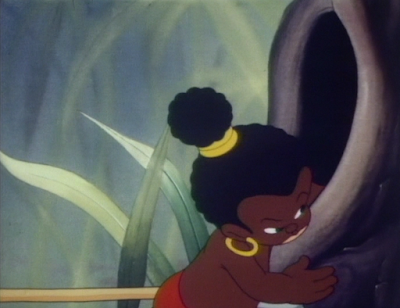













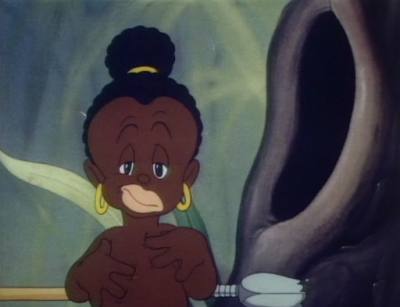












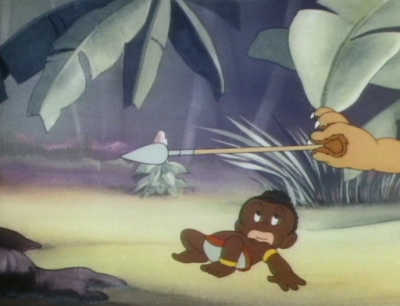












































































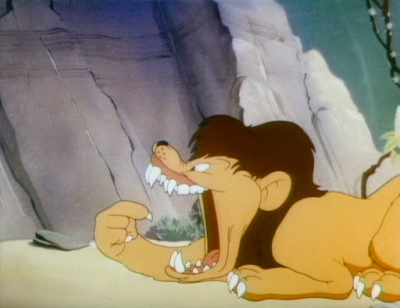














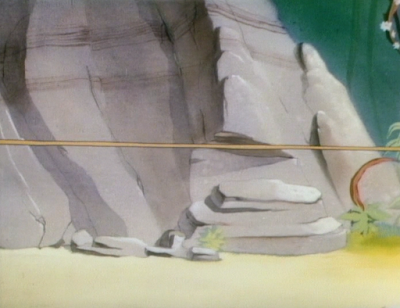
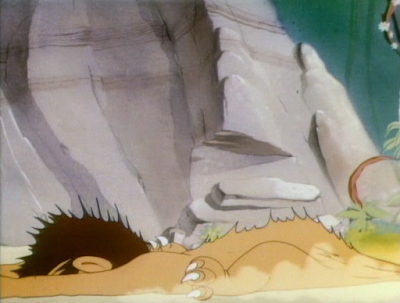














One thing I'll never understand is why the Inki cartoons weren't pulled by UA when they pulled the Censored 11 shorts.
ReplyDelete